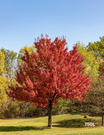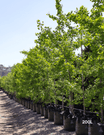As spring approaches, there’s no better time to get your garden in shape for the warmer months ahead. Whether revamping an existing landscape or planning new plantings, spring offers the perfect opportunity to refresh your outdoor space with vibrant, high-quality trees that enhance beauty and function. Preparing your garden for spring doesn’t need to be overwhelming—these five essential steps will ensure your garden thrives, looks pristine, and reflects the elegance of a high-end space.
Step 1: Clean Up Your Garden
A great garden begins with cleanliness. Start by removing dead leaves, fallen branches, and any debris accumulated over the winter months. These items can create a breeding ground for pests and diseases, which could affect your spring plantings. Cleaning up ensures your garden is ready for fresh growth.
- Prune dead branches from trees and shrubs, particularly those that may hinder new growth.
- Rake fallen leaves to allow sunlight to reach the soil, promoting a healthier environment for your plants.
- Weed thoroughly, removing any stubborn weeds that could compete with your trees and flowers for nutrients.
Spring cleaning is essential for preparing a healthy, vibrant garden that will flourish as temperatures rise.
Step 2: Test Your Soil
Testing your soil to understand its nutrient composition is critical before planting. A soil test provides insights into the pH level, nutrient deficiencies, and the amendments needed to give your plants the best chance of success.
- Check soil pH to ensure it suits the trees you plan to plant. Some species prefer acidic soils, while others thrive in alkaline conditions.
- Amend the soil with organic compost or well-rotted manure to improve texture, fertility, and drainage.
- Aerate compacted areas to encourage deeper root growth and increase the availability of nutrients.
Testing your soil ensures that your trees, such as the Pyrus calleryana 'Bradford', are planted in optimal conditions, which helps them grow strong and healthy.
Step 3: Plan New Plantings
With a clean, nutrient-rich garden, it’s time to plan your spring plantings. Carefully selecting trees complement your garden’s design and environmental conditions is crucial for achieving a cohesive, luxurious look. Here are three exceptional choices for a high-end garden:
Pyrus calleryana 'Bradford'
Known for its striking white blooms in spring and vibrant autumn foliage, the Pyrus calleryana 'Bradford' is an elegant choice for gardens looking to make a seasonal statement. This deciduous tree can serve as a feature tree or an ornamental addition to your garden. Its upright shape and dense canopy create a grand visual impact, making it perfect for pathways, driveways, or as a garden focal point.
Key Facts:
- Mature Height: 12-15m
- Mature Width: 6-8m
- Best Uses: Feature trees, driveways, large garden spaces
- Leaf Appearance: Glossy green foliage, turning deep red to purple in autumn
- Rate of Growth: Moderate
- Tolerates: Urban pollution, wind, frost
Why It's Perfect to Add to Your Garden
The Pyrus calleryana 'Bradford' is a beautiful way to add both spring blooms and autumn colors to your garden. Its symmetrical shape and adaptability to various soil types make it ideal for high-end landscapes that value aesthetics and low maintenance. It’s particularly well-suited for larger properties where its full grandeur can be appreciated.
Syzygium paniculatum 'Backyard Bliss'
For those seeking an evergreen option that offers privacy and structure, Syzygium paniculatum 'Backyard Bliss' is an outstanding choice. This Australian native is a dense, fast-growing shrub that provides year-round coverage, making it ideal for screening or hedging. Its glossy, dark green leaves and compact growth make it a refined, stylish addition to any high-end garden.
Key Facts:
- Mature Height: 3-4m
- Mature Width: 1.5-2m
- Best Uses: Privacy hedge, screening, windbreak
- Leaf Appearance: Dark green, glossy foliage
- Rate of Growth: Fast
- Tolerates: Drought, light frost, urban conditions
Why It's Perfect to Add to Your Garden
Syzygium paniculatum 'Backyard Bliss' is a premium option for creating a refined, private garden space. It’s easy to maintain, and its dense foliage offers a natural barrier without feeling heavy or intrusive. This makes it perfect for urban environments where privacy is key but where the garden's aesthetic appeal still holds importance.
Waterhousea floribunda (Weeping Lilly Pilly)
If you want to add a touch of elegance with a softer, more flowing tree, the Waterhousea floribunda, also known as the Weeping Lilly Pilly, is an exceptional choice. Its drooping branches and lush green foliage create a calming, serene presence in any garden. Ideal for feature planting, this tree offers a graceful yet bold aesthetic.
Key Facts:
- Mature Height: 8-12m
- Mature Width: 4-6m
- Best Uses: Feature tree, screening, shade
- Leaf Appearance: Glossy, dark green leaves with bronze new growth
- Rate of Growth: Moderate
- Tolerates: Frost, humidity, coastal conditions
Why It's Perfect to Add to Your Garden
The Waterhousea floribunda adds a dynamic visual appeal with its weeping branches and lush foliage, providing shade and beauty. It’s a versatile tree that can be used as a feature in larger garden areas or as a stunning screen for privacy. Its tolerance for coastal and urban environments makes it a highly adaptable choice for a wide range of luxury gardens.
Step 4: Mulch and Fertilize
Once your trees are planted, it’s crucial to mulch and fertilize. Mulching helps to retain moisture, suppress weeds, and regulate soil temperature. Fertilizing ensures your trees have the nutrients they need to grow robustly during spring.
- Apply a 5-7cm layer of organic mulch around the base of your trees, ensuring the mulch doesn't touch the trunk.
- Use a slow-release fertilizer that provides steady nutrients throughout the growing season.
- Water well after mulching to help the nutrients seep into the soil.
Mulching and fertilizing are simple but vital steps in ensuring your garden thrives throughout the season.
Step 5: Irrigation and Ongoing Care
Spring is the time to check your irrigation system and ensure it’s working efficiently. Trees, particularly young or newly planted, will need consistent watering to establish deep roots and withstand warmer weather.
- Inspect your irrigation system for leaks or blockages.
- Set your system to water deeply but infrequently, encouraging deep root growth.
- Regularly check soil moisture levels to avoid over- or under-watering.
A consistent watering routine is essential for establishing healthy growth for newly planted trees like the Syzygium paniculatum 'Backyard Bliss'.
FAQs
Q: How often should I water my newly planted trees?
A: Water your new trees deeply once or twice a week, depending on rainfall. Ensure the soil is consistently moist but not soggy.
Q: Can I plant trees in early spring?
A: Absolutely! Early spring is an ideal time to plant trees, as the soil is warming up, and trees have the entire growing season to establish.
Q: What should I do if my soil is too acidic or alkaline?
A: Amend the soil with lime for acidic soils or sulfur for alkaline soils. A soil test will provide a clear guide on what adjustments are needed.








































Leave a comment
This site is protected by hCaptcha and the hCaptcha Privacy Policy and Terms of Service apply.